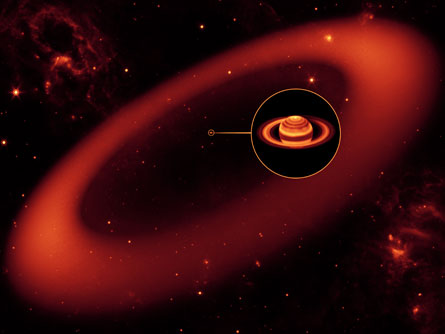One ring around them all
Introducing the solar system's largest known ring around a planet
Share this:
- Share via email (Opens in new window) Email
- Click to share on Facebook (Opens in new window) Facebook
- Click to share on X (Opens in new window) X
- Click to share on Pinterest (Opens in new window) Pinterest
- Click to share on Reddit (Opens in new window) Reddit
- Share to Google Classroom (Opens in new window) Google Classroom
- Click to print (Opens in new window) Print
 |
|
I suspect that textbooks may now need to be rewritten.
|
| NASA |
Astronomers recently found another ring around the planet Saturn — and it’s the biggest one yet. This newly discovered ring stretches about 15 million miles across, which makes a loop big enough to fit a billion Earths inside. It may be even bigger, say the astronomers, and reach 22 million miles across at its diameter.
Saturn’s new ring is now the biggest known ring in the solar system. (The solar system includes the sun and all the planets and other objects that orbit around it.)
“It’s an exciting discovery,” John Spencer told Science News. He is a scientist at the Southwest Research Institute in Boulder, Colo., and studies planets.
Astronomers found the ring in February, but they did not find it using telescopes here on Earth. Instead, they used NASA’s Spitzer Space Telescope, a spacecraft that trails Earth in an orbit about the sun and takes pictures of deep space. The Spitzer telescope does not take pictures using visible light, like most telescopes or cameras. Instead, it detects infrared energy, which is energy (like heat) which cannot be seen with the naked eye.
Light travels in waves, and the waves of infrared light are shorter than the waves of visible light. Waves of energy coming from the newly discovered ring are estimated to be about 30 microns apart — so tiny that about 1,000 waves would fit on your thumb nail.
This ring, like Saturn’s other rings, is not one solid piece of rock. Instead, it is made up of millions or billions of tiny rocks that orbit the planet all together and give the appearance of a unified ring. Unlike the more visible rings, however, this big one is ghostly — the pieces are far apart, and the ring cannot be seen from the surface of the Earth. If all the pieces were stuck together, they’d be slightly bigger than a rock a half-mile wide.
Astronomers suspect that the newly discovered ring gets its material from Saturn’s outermost moon, Phoebe. For example, the dust in the ring circles Saturn in the same path and the same direction as Phoebe. Plus, the surface of Phoebe is marked with holes and places where rock has been knocked away, the result of collisions between Phoebe and other moons and rocks. These collisions could have sent dust out into space, to become part of the big ring.
The discovery of the ring could help explain other mysteries surrounding Saturn and its dozens of moons. The moon called Iapetus, for example, is two-toned: one side is gray; the other more reddish. Iapetus is within the newly discovered ring, but it orbits in the opposite direction. As a result, some researchers say, debris from the ring may have coated and colored one side of Iapetus as it moved through space, and left the other side alone.
“The cause of Iapetus’ bizarre yin-yang [color] distribution … has been a nagging puzzle that now seems solved,” said Joseph Burns, a planetary scientist at Cornell University who talked about the discovery at a recent meeting of astronomers.
Not everyone agrees. Spencer, for example, thinks the ring alone may not be able to explain Iapetus’ funny coloring. To know for sure, researchers will have to look harder at the ringed planet — and at the biggest ring of all.
POWER WORDS
infrared The range of invisible radiation with wavelengths from about 750 nanometers (just longer than red in the visible spectrum) to 1 millimeter, on the border of the microwave region
telescope An arrangement of lenses or mirrors or both that gathers visible light, permitting direct observation or photographic recording of distant objects
micron A unit of length equal to one millionth of a meter.
moon A natural satellite orbiting around a planet.
Going Deeper:







